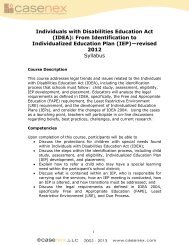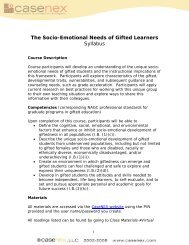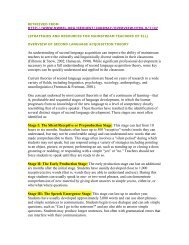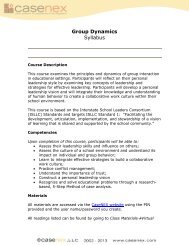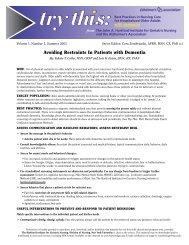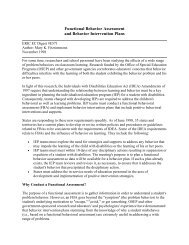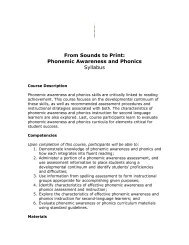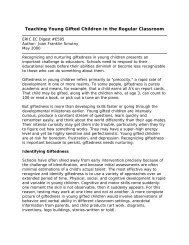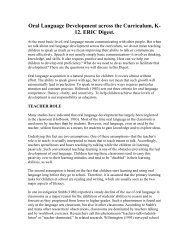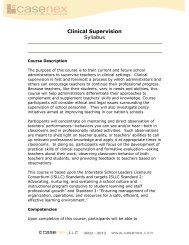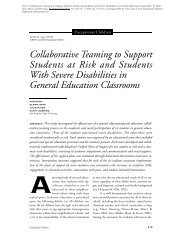Challenging Gifted Students in the Regular Classroom - Casenex
Challenging Gifted Students in the Regular Classroom - Casenex
Challenging Gifted Students in the Regular Classroom - Casenex
You also want an ePaper? Increase the reach of your titles
YUMPU automatically turns print PDFs into web optimized ePapers that Google loves.
<strong>Challeng<strong>in</strong>g</strong> <strong>Gifted</strong> <strong>Students</strong> <strong>in</strong> <strong>the</strong> <strong>Regular</strong> <strong>Classroom</strong><br />
ERIC EC Digest #E513<br />
Author: Beverly N. Parke<br />
December 1992<br />
How do teachers develop an <strong>in</strong>structional plan that will be challeng<strong>in</strong>g,<br />
enlighten<strong>in</strong>g, and <strong>in</strong>trigu<strong>in</strong>g to students of different abilities, and still<br />
ma<strong>in</strong>ta<strong>in</strong> a sense of community with<strong>in</strong> <strong>the</strong> classroom? This is <strong>the</strong> central<br />
question for educators as <strong>the</strong>y beg<strong>in</strong> <strong>the</strong> quest of br<strong>in</strong>g<strong>in</strong>g sound <strong>in</strong>struction<br />
to gifted students <strong>in</strong> regular classroom sett<strong>in</strong>gs.<br />
Research tells us that a large majority of gifted and talented students spend<br />
most of <strong>the</strong>ir day <strong>in</strong> regular classroom sett<strong>in</strong>gs (Cox, Daniel, & Boston,<br />
1985). Unfortunately, <strong>in</strong>struction <strong>in</strong> <strong>the</strong> regular classroom sett<strong>in</strong>g is<br />
generally not tailored to meet <strong>the</strong>ir unique needs (Archambault et al., 1993;<br />
Cox, Daniel, & Boston, 1985; Westberg, Archambault, Dobyns, & Salv<strong>in</strong>,<br />
1993). This situation is putt<strong>in</strong>g gifted students at risk of fail<strong>in</strong>g to achieve<br />
<strong>the</strong>ir potential. Achievement scores below what might be expected from our<br />
brightest population provide <strong>the</strong> evidence (Callahan, 1990; Kantrowitz &<br />
W<strong>in</strong>gert, 1992; Ness & Latessa, 1979).<br />
The challenge for educators is twofold. Our gifted and talented population<br />
must have a full service education if we expect <strong>the</strong>se students to thrive <strong>in</strong><br />
<strong>the</strong> manner <strong>in</strong> which <strong>the</strong>y are capable. Second, <strong>the</strong>se students must be<br />
<strong>in</strong>volved <strong>in</strong> educational experiences that are challeng<strong>in</strong>g and appropriate to<br />
<strong>the</strong>ir needs and achievement levels. The place to beg<strong>in</strong> is <strong>in</strong> <strong>the</strong> regular<br />
classroom.<br />
What Are <strong>the</strong> Steps to Full Service?<br />
The goal for program planners deal<strong>in</strong>g with <strong>the</strong> challenges of meet<strong>in</strong>g<br />
<strong>in</strong>structional needs of gifted and talented students <strong>in</strong> regular classroom<br />
sett<strong>in</strong>gs is to create a learn<strong>in</strong>g environment <strong>in</strong> which <strong>the</strong>se students can fully<br />
develop <strong>the</strong>ir abilities and <strong>in</strong>terests without los<strong>in</strong>g <strong>the</strong>ir sense of membership<br />
as part of <strong>the</strong> class. This is a tall order for teachers and students, because<br />
<strong>the</strong> usual remedy is to segregate <strong>the</strong>se students <strong>in</strong>to small homogeneous<br />
groups or to assign <strong>in</strong>dividual projects. While both of <strong>the</strong>se strategies have<br />
<strong>the</strong>ir place, nei<strong>the</strong>r is sufficient to accomplish <strong>the</strong> goal. Therefore, we must<br />
look beyond <strong>the</strong> conventional, consider <strong>the</strong> overall dynamics of <strong>the</strong><br />
classroom, and plan for a work<strong>in</strong>g environment <strong>in</strong> which all <strong>the</strong> students can<br />
fully develop <strong>the</strong>ir abilities and <strong>in</strong>terests with<strong>in</strong> <strong>the</strong> conf<strong>in</strong>es of one<br />
organizational unit.
What Are <strong>the</strong> Characteristics of <strong>Students</strong> Who Are <strong>Gifted</strong> and<br />
Talented?<br />
When asked this question, most teachers will respond by cit<strong>in</strong>g three<br />
observations. First, gifted youngsters tend to get <strong>the</strong>ir work done quickly<br />
and may seek fur<strong>the</strong>r assignments or direction. Second, <strong>the</strong>y ask prob<strong>in</strong>g<br />
questions that tend to differ from <strong>the</strong>ir classmates <strong>in</strong> depth of understand<strong>in</strong>g<br />
and frequency. F<strong>in</strong>ally, <strong>the</strong>y have <strong>in</strong>terests <strong>in</strong> areas that are unusual or more<br />
like <strong>the</strong> <strong>in</strong>terests of older students. In fact, <strong>the</strong>se observations def<strong>in</strong>e <strong>the</strong><br />
characteristics that challenge regular classroom teachers <strong>the</strong> most as <strong>the</strong>y<br />
attempt to br<strong>in</strong>g full <strong>in</strong>structional service to gifted and talented students.<br />
These students potentially differ from <strong>the</strong>ir classmates on three key<br />
dimensions (Maker, 1982):<br />
1. <strong>the</strong> pace at which <strong>the</strong>y learn<br />
2. <strong>the</strong> depth of <strong>the</strong>ir understand<strong>in</strong>g<br />
3. <strong>the</strong> <strong>in</strong>terests that <strong>the</strong>y hold.<br />
In order to develop <strong>in</strong>structional programs that will meet <strong>the</strong> needs of gifted<br />
students <strong>in</strong> regular classroom sett<strong>in</strong>gs, it is necessary to address and<br />
accommodate <strong>the</strong>se def<strong>in</strong><strong>in</strong>g characteristics.<br />
What Is <strong>the</strong> Role of <strong>the</strong> <strong>Regular</strong> <strong>Classroom</strong> Teacher?<br />
Most teachers have, on occasion, had students <strong>in</strong> <strong>the</strong>ir classes who know<br />
more than <strong>the</strong>y do about some specific topics <strong>the</strong>y are teach<strong>in</strong>g. Teachers<br />
who see <strong>the</strong>mselves as facilitators of learn<strong>in</strong>g can f<strong>in</strong>d a great deal to offer<br />
<strong>the</strong>se students. As a facilitator, orchestrator, designer, or coach, <strong>the</strong> teacher<br />
presents <strong>the</strong> conditions for learn<strong>in</strong>g. He or she helps <strong>the</strong> student develop <strong>the</strong><br />
skills necessary to learn, understand, and <strong>in</strong>terpret an appropriately<br />
differentiated curriculum. This role requires teachers to have skills <strong>in</strong> both<br />
<strong>the</strong>ir subject areas (understand<strong>in</strong>g its content, <strong>the</strong> manner <strong>in</strong> which its<br />
professionals th<strong>in</strong>k) and <strong>in</strong> <strong>the</strong> management of learn<strong>in</strong>g.<br />
What Program Options Are Needed to Meet <strong>the</strong> Needs of These<br />
<strong>Students</strong>?<br />
One of <strong>the</strong> greatest mistakes made by school districts attempt<strong>in</strong>g to deliver<br />
programm<strong>in</strong>g to <strong>the</strong>ir gifted and talented students is that <strong>the</strong>y look for<br />
unidimensional approaches. The heterogeneity of <strong>the</strong> gifted population<br />
leaves only one remedy that has any chance of succeed<strong>in</strong>g over <strong>the</strong> long<br />
haul. That is a multiple programm<strong>in</strong>g approach (Cox, Daniel, & Boston,<br />
1985; Parke, 1989)--one <strong>in</strong> which a constellation of programs is available <strong>in</strong><br />
which students can participate based on <strong>the</strong>ir abilities, needs, and <strong>in</strong>terests.
Some of <strong>the</strong>se options may be specifically tailored to high ability students<br />
(such as Advanced Placement, honors, or resource room programs). O<strong>the</strong>rs<br />
may be found <strong>in</strong> <strong>the</strong> course list<strong>in</strong>gs for general education that are available<br />
to all students but which serve gifted and talented students well (such as<br />
student council, school newspaper, Future Problem Solv<strong>in</strong>g, computer club,<br />
etc.). Profiles of students' abilities, derived from comprehensive assessment<br />
batteries, can be used to match students to appropriate programs.<br />
What Instructional Provisions must Be Made?<br />
Design<strong>in</strong>g <strong>in</strong>structional opportunities for gifted students <strong>in</strong> regular<br />
classrooms f<strong>in</strong>ds its <strong>in</strong>spiration at <strong>the</strong> source of <strong>the</strong> concern--<strong>the</strong> students.<br />
The characteristics of <strong>the</strong>se students lead to <strong>the</strong> <strong>in</strong>structional<br />
accommodations that are appropriate (The Association for <strong>Gifted</strong>, 1989). The<br />
accelerated pace at which gifted and talented students learn <strong>in</strong>formation<br />
requires that flexible pac<strong>in</strong>g strategies (Daniel & Cox, 1988) such as skill<br />
group<strong>in</strong>g, curricular compact<strong>in</strong>g, contract<strong>in</strong>g, and credit by exam<strong>in</strong>ation be<br />
<strong>in</strong>tegrated <strong>in</strong>to classroom management formats. The need to explore topics<br />
<strong>in</strong> depth leads program planners to <strong>in</strong>clude provisions such as orig<strong>in</strong>al<br />
research, <strong>in</strong>dependent studies or <strong>in</strong>vestigations, mentorships, or classes at<br />
ano<strong>the</strong>r school or <strong>in</strong>stitution of higher learn<strong>in</strong>g. When address<strong>in</strong>g <strong>the</strong> unique<br />
or advanced <strong>in</strong>terests of <strong>the</strong>se students, planners might be <strong>in</strong>spired to<br />
<strong>in</strong>clude opportunities such as m<strong>in</strong>icourses, <strong>in</strong>terest groups, clubs, science or<br />
art fairs, or <strong>in</strong>ternships. The teachers' challenge is to identify student needs,<br />
develop and ga<strong>in</strong> access to appropriate programs and curricula that<br />
correspond to those needs, and monitor student progress throughout <strong>the</strong><br />
course of study. The students' challenge is to make <strong>the</strong> best possible use of<br />
<strong>the</strong> resources available while becom<strong>in</strong>g fully responsible for <strong>the</strong>ir own<br />
learn<strong>in</strong>g.<br />
References<br />
Archambault, F., Westberg, K., Brown, S., Hallmark, B., Zhang, W., &<br />
Emmons, C. (1993). "<strong>Classroom</strong> practices used with gifted third and fourth<br />
grade students." Journal for <strong>the</strong> Education of <strong>the</strong> <strong>Gifted</strong>,16 (2), 13-28.<br />
Callahan, C. (1990). "A commissioned paper on <strong>the</strong> performance of high<br />
ability students on national and <strong>in</strong>ternational tests." Unpublished paper,<br />
University of Virg<strong>in</strong>ia, Charlottesville.<br />
Cox, J., Daniel, N., & Boston, B. (1985). "Educat<strong>in</strong>g able learners: Programs<br />
and promis<strong>in</strong>g practices." Aust<strong>in</strong>, TX: University of Texas Press. ED 266 567.
Daniel, N. & Cox, J. (1988). "Flexible pac<strong>in</strong>g for able learners." Reston, VA:<br />
Council for Exceptional Children. ED 298 725.<br />
Kantrowitz, B. & W<strong>in</strong>gert, P. (1992, February 17). "An 'F' <strong>in</strong> world<br />
competition." Newsweek, p.57.<br />
Maker, J. (1982). "Curriculum development for <strong>the</strong> gifted." Rockville, MD:<br />
Aspen Systems Corporation.<br />
Ness, B. & Latessa, E. (1979). "<strong>Gifted</strong> children and self-teach<strong>in</strong>g<br />
techniques." Directive Teacher, 2, 10-12.<br />
Parke, B. (1989). "<strong>Gifted</strong> students <strong>in</strong> regular classrooms." Boston: Allyn &<br />
Bacon.<br />
The Association for <strong>Gifted</strong>. (1989). "Standards for programs <strong>in</strong>volv<strong>in</strong>g <strong>the</strong><br />
gifted and talented." Reston, VA: Council for Exceptional Children. ED 375<br />
924.<br />
Westberg, K., Archambault, F., Dobyns, S., & Salv<strong>in</strong>, T. (1993). "The<br />
classroom practices observation study." Journal for <strong>the</strong> Education of <strong>the</strong><br />
<strong>Gifted</strong>, 16 (2), 29-56.<br />
Additional Read<strong>in</strong>g<br />
Berger, S. L. (1991). "Differentiat<strong>in</strong>g curriculum for gifted students." Reston,<br />
VA: CEC/ERIC. ED 342 175.<br />
"Meet<strong>in</strong>g <strong>the</strong> needs of able learners through flexible pac<strong>in</strong>g" (1990). Reston,<br />
VA: CEC/ERIC. ED 314 916.<br />
VanTassel-Baska, J. (1992). "Plann<strong>in</strong>g effective curriculum for gifted<br />
learners." Denver: Love Publish<strong>in</strong>g.<br />
VanTassel-Baska, J. (1992). "Develop<strong>in</strong>g learner outcomes for gifted<br />
students." Reston, VA: CEC/ERIC. ERIC EC Digest #E514.<br />
ERIC Digests are <strong>in</strong> <strong>the</strong> public doma<strong>in</strong> and may be freely reproduced and dissem<strong>in</strong>ated, but<br />
please acknowledge your source. This publication was prepared with fund<strong>in</strong>g from <strong>the</strong> U.S.<br />
Department of Education, Office of Educational Research and Improvement, under Contract<br />
No. RI88062207. The op<strong>in</strong>ions expressed <strong>in</strong> this report do not necessarily reflect <strong>the</strong><br />
positions or policies of OERI or <strong>the</strong> Department of Education.
Copyright ©1996<br />
ERIC Clear<strong>in</strong>ghouse on Disabilities and <strong>Gifted</strong> Education<br />
http://ericec.org<br />
ERIC Digests are <strong>in</strong> <strong>the</strong> public doma<strong>in</strong> and may be freely reproduced and dissem<strong>in</strong>ated. However, all o<strong>the</strong>r <strong>in</strong>formation<br />
on this site is copyrighted and may not be used without permission.<br />
Retrieved from: http://ericec.org/digests/e513.html on July 21, 2006<br />
ERIC EC Digest #E513<br />
Author: Beverly N. Parke<br />
December 1992



